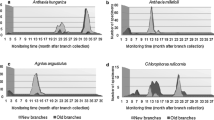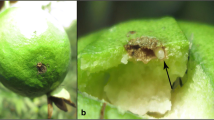Summary
The twolined chestnut borer, Agrilus bilineatus (Weber) (Coleoptera: Buprestidae), attacks oaks (Quercus spp.) and is associated with extensive mortality of trees in the eastern deciduous forests of North America. We tested the hypothesis that winter starch reserves of oak roots are an indicator of tree vigor and that only trees low in stored starch would be attacked by A. bilineatus. We measured the levels of stored starch in the roots of 200 non-infested healthy white oaks during the dormant season and determined their correlation with A. bilineatus attacks the following spring. There was a significant increase in A. bilineatus captures on sticky traps with a decrease in winter starch reserves. Trees low in stored starch that were also stressed by phloem-girdling attracted 3.7 times as many beetles as did non-girdled trees that were low in starch. However, non-girdled trees that had low winter starch reserves were also attacked. Only oaks that had had extremely low winter root starch reserves (<5mg/g dry weight of root sapwood tissue) were heavily attacked by A. bilineatus and subsequently died. One third of non-girdled low starch trees and 67% of phloem-girdled low starch trees died, whereas none of the trees with root starch >5 mg/g dry wt died. These results indicate that winter starch reserves are a good predictor of A. bilineatus attack.
Similar content being viewed by others
References
Barter GW (1957) Studies of the bronze borch borer, Agrilus anxius Gory, In New Brunswick. Can Entomol 89:12–36
Pryant JP, Chapin FS III, Klein DR (1983) Carbon/nutrient balance of boreal plants in relation to vertebrate herbivory. Oikos 40:357–368
Campbell RW, Sloan RJ (1977) Forest stand responses to defoliation by the gypsy moth. For Sci Monogr 19
Cote WA, Allen DC (1980) Biology of two-lined chestnut borer, Agrilus bilineatus, in Pennsylvania and New York. Ann Entomol Soc Am 73:409–413
Dunbar DM, Stepens GR (1975) Association of two-lined chestnut borer and shoestring fungus with mortality of defoliated oak in Connecticut. For Sci 22:169–174
Dunbar DM, Stephens GR (1976) The bionomics of the twolined borer. In: Anderson JF, Kaya HK (eds) Perspectives in forest Entomology. Academic Press, New York, pp 73–83
Dunn JP (1985) Attraction of the twolined chestnut borer, Agrilus bilineatus, and other associated borers to stressed white oak, Quercus alba. MS Thesis, University of Kentucky, p 113
Dunn JP, Kimmerer TW, Nordin GL (1986a) The role of host tree condition in attack of white oaks by the twolined chestnut borer, Agrilus bilineatus (Weber) (Coleoptera: Buprestidae). Oecologia (Berlin) 70:596–600
Dunn JP, Kimmerer TW, Nordin GL (1986b) Attraction of the twolined chestnut borer, Agrilus bilineatus (Weber) (Coleoptera: Buprestidae) and associated borers to volatiles of stressed white oak. Can Entomol 118:503–509
Ebell LF (1969) Specific total starch determinations in conifer tissues with glucose oxidase. Phytochemistry 8:25–36
Goldstein P, Lampen JO (1975) 3-D-fructofuranoside fructohydrolase from yeast. In: Ward WA (ed) Methods in enzymology. Academic Press, New York, pp 504–511
Haack RA, Benjamin DM (1982) The biology and ecology of the twolined chestnut borer, Agrilus bilineatus, on oaks, Quercus spp in Wisconsin. Can Entomol 114:385–395
Hollander M, Wolfe DA (1973) Nonparametric Statistical Methods. John Wiley and Sons, New York
Houston DR (1981) Oak decline and mortality. In: Doane CC, McManus ML (eds) The gypsy moth: research toward integrated pest management. USDA For Ser Tech Bull 1584, pp 217–225
Hursh CR, Haasis FW (1931) Effects of the 1925 summer drought on southern appalachian hardwoods. Ecology 12:380–386
McLaughlin SB, McConathy RK, Barnes RL, Edwards NT (1980) Seasonal changes in energy allocation by white oak (Quercus alba). Can J For Res 10:379–388
Nichols JO (1968) Oak mortality in Pennsylvania: A ten-years study. J For 66:681–694
Overstreet JB (1984) Robinson forest inventory: 1980–1982, Breathitt, Knott, and Perry counties Kentucky. Univ Ky Dept Forestry Coll Agric Publ 50-5-84, Lexington Ky, pp54
Parker J (1976) Effects of defoliation on levels of chlorogenic acid in oak bark. Plant Physiol Suppl 57:S 64
Parker J (1977) Phenolics in lack oak bark and leaves. J Chem Ecol 3:489–496
Parker J, Patton RL (1975) Effects of drought and defoliation on some metabolites in roots of black oak seedlings. Can J For Res 5:457–563
Sanderson GW, Perera BPM (1966) Removal of polyphenolic compounds interfering with carbohydrate determination in plant extracts with an insoluble polyphenol absorbent. Analyst (London) 91:335–336
Staley JM (1965) Decline and mortality of red oak and scarlet oak. For Sci 11:2–17
Stephens GR, Hill DE (1971) Drainage, drought, defoliation and death in unmanaged conneticut forests. Con Agric Exp For Stn bull 718
Stringer JW, Kimmerer TW, Overstreet JB (1987) Oak mortality in Kentucky. In: Hay R (ed) Proceedings Sixth Central Hardwood forest conf. Knoxville, TN (in press)
Wargo PM (1975) Estimating starch content in roots of deciduous trees — a visual technique. USDA For Ser Res Pap no 313
Wargo PM (1977) Variation of starch content among and within roots of red and white oak trees. Forest Sci 22:468–471
Wargo PM (1981) Measuring response of trees to defoliation stress. In: Doane CC, McManus (eds) The gypsy moth: research toward integrated pest management. USDA For Ser Tech Bull 1584, pp 225–267
Waring RH, Pitman GB (1985) Modifying lodgepole pine stands to change susceptibility to mountain pine beetle attack Ecology 66:889–897
Author information
Authors and Affiliations
Additional information
The investigation reported in this paper (No. 87-7-8-118) is in connection with a project of the Kentucky Agricultural Experiment Station and is published with the approval of the Director
Rights and permissions
About this article
Cite this article
Dunn, J.P., Kimmerer, T.W. & Potter, D.A. Winter starch reserves of white oak as a predictor of attack by the twolined chestnut borer, Agrilus bilineatus (Weber) (Coleoptera: Buprestidae). Oecologia 74, 352–355 (1987). https://doi.org/10.1007/BF00378929
Received:
Issue Date:
DOI: https://doi.org/10.1007/BF00378929




